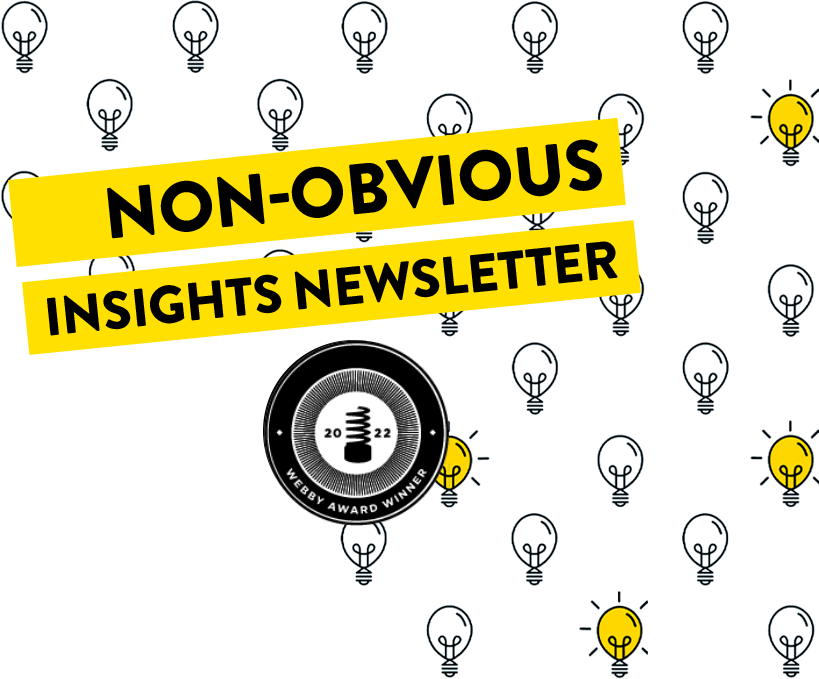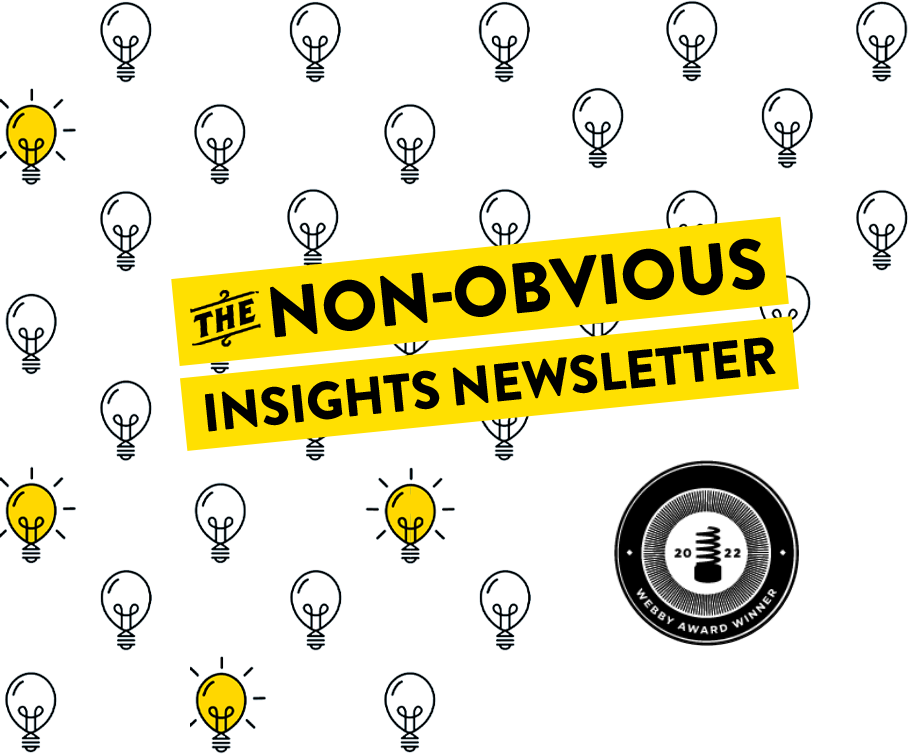Dear Fellow Trend Curator,
In this week’s edition, I decided to take an unexpected deep dive into the world of art and museums. You’ll find several stories and recommended reading on this topic below including a book that was featured in last year’s Non-Obvious Book Awards.
In other stories, two brothers buy an abandoned Boeing 727 for $10k, Digg may soon be reborn, a new paint makes buildings “sweat” to help them keep cool, how technology is changing the way perfumes get made and marketing secrets from the underdog political campaign of New York Mayor candidate Zohran Mamdani.
Enjoy the stories and stay curious!
The Talking Statues of Versailles
When my kids were younger (and probably today too!) one of our favorite family movies was Night at the Museum. The idea of museums coming to life was fun to imagine. This week, The Palace of Versailles in France teamed up with Ask Mona and OpenAI to help “twenty iconic fountains and statues from the Gardens become narrators of their own stories. For the first time at Versailles, these masterpieces of heritage speak and engage in conversations with the public.”
Accessible via an app or a QR code placed near the statues, the tool lets you have a conversation with the sculpture in 13 different languages. Though I haven’t tried the experience for myself, I do love this idea of bringing artwork to life by allowing visitors to learn about its story through something other than a boring placard affixed to the wall. What do you think? If you were visiting the Palace, would you use this?
Digg, the Internet’s Favorite Defunct Brand Is Coming Back
If you were around for the early days of the Internet, you might remember Digg. It was a collection of interesting stories that was so popular that at one stage it was popularly referred to as the “homepage of the Internet.” Then in 2018 after an ownership shuffle, the site was permanently shut down … until now. The big news in tech circles this week was the reboot of Digg. Though still just in private alpha mode for early reviewers the site has a relatable vision and mission behind it:
“We are going to live in a world where the vast, vast majority of the content we’re seeing is in … some shape or form, AI-generated, and it is a terrible user experience if the reason you’re coming to a place is for authentic human connection, and it’s not with humans — or it’s with people masquerading as humans.”
Many of the features that site founders Alexis Ohanian and the site’s original founder Kevin Rose are envisioning sound promising, such as verifying humans using the platform and finding a business model that allows the site to compensate their most active moderators and creators. The initial experience looks very promising, and the timing is perfect with one of my favorite curation tools (Pocket) officially shutting its doors. This is definitely one to sign up for and experiment with.
How Technology Is Changing the Way Perfume Gets Made
As AI enters perfumery, are we expanding access to beauty — or automating the soul out of it?” This is the provocative question asked in an article I came across this week outlining the growing role of AI and technology in helping to develop new scents.
“From concept to shelf, a single perfume can take six to 18 months — even longer in luxury. And like fine wines, fragrance materials vary with climate concerns. One year’s yield will not smell like the next one, or the one before. Perhaps this will be true democratization of fragrance because it drastically reduces the cost of creating one. But it does make you ask: Where’s the craftsmanship? Where’s the perfumer?”
The availability of these new tools for formulating new scents is likely to explode this category. In 2023 there were more than 3,000 new scents (compared to just 400 new fragrances in 1995). The more fragrances produced, the more important marketing and storytelling is likely to become when launching those perfumes into the world.
Inside the Relentlessly Cheerful Campaign of Zohran Mamdani
Amidst all the coverage of what some news outlets described as a “political earthquake” with relative newcomer Zohran Mamdani defeating longtime NY politician Andrew Cuomo in the primary for the Mayor’s race, there was this fascinating summation of the campaign run by the 33 year old Indian-American candidate:
“Mr. Mamdani ran a relentless and cheerful campaign focused on affordability in a city that has grown too expensive for an expanding circle of residents, with zippy videos and catchy tag lines like “freeze the rent” and “free buses” that told voters he cared first about their wallets.”
His unexpected victory has earned national attention and is causing panic among several groups. Central to his success has been his ability to use break through marketing to focus on the biggest issue faced every day by anyone living in New York: affordability. His social media posts explain the issues in simple terms and offer down to earth promises for what he would focus on doing if elected (ie – freeze rents, offer free busses and reduce grocery prices).
The style of campaign he seems to be running is capturing attention around the world, and in NY as well. As a result, more than a few observers are predicting his style may become a model for other campaigns and aspiring politicians to watch.
How One Museum Is Reinventing the Way Collections Are Shown
Shown
Imagine spending a day at a museum without seeing the actual exhibits but instead visiting the warehouse where they keep everything that isn’t on display. That’s the non-obvious concept behind the V&A East Storehouse that just opened on the east side of London. Affiliated with the Victoria and Albert family of museums, this venue built on the site of the former London 2012 Olympics Media Centre houses over 250,000 objects, 350,000 library books and 1,000 archives.
“Storehouse is a new kind of museum experience. It gives you a chance to see behind the scenes of a working museum, explore why and how objects get collected by museums, find out how they are cared for, and uncover the stories they tell about us and our world.”
The space also includes pop-up displays, workshops, performances and screenings. One of the most interesting features will be their Order an Object experience, where you can book to see an artifact up close ahead of time and curators will personally show it to you. The whole concept is aimed at “providing radical access to the national collections held by the V&A” and just opened a few weeks ago.
The Non-Obvious Media Recommendation of the Week
ARTNews
How much do you know about the latest developments in the world of global art? Unless you work in the industry or are an avid art lover, the answer is probably not much. ARTNews is a long-running publication that describes itself as “the most trusted source for news of the global art world and the art market.” They do one print edition a year, their popular Top 200 Collectors issue, but the daily stories on the site explore the role of contemporary art in our culture, the business of art (and art crime) and emerging trends in art and beyond. For bringing you a world that you may only selectively experience otherwise, ARTNews is my pick for this week’s non-obvious media recommendation.
The Non-Obvious Book of the Week
The Problems in the Art World by Brainard Carey
Being an artist is hard. When you choose to do it professionally, you’ll likely face many problems. According to Brainard Carey, the renowned director of the Praxis Center for Aesthetics, you may encounter exactly 26 problems to overcome–and so he published a book about how to do it. While his book is clearly written for artists, many of the problems explored in the book from the problem of attracting mentors and patrons to the problem of scams designed to extract money from artists, Carey’s book starts with exposing each problem and then makes it relatable and conquerable through concrete advice and short chapters. You don’t have to be an artist to find value in this book. Through reading these suggestions for empowering artists to achieve success, you might find some useful advice for your own situation too.
About the Non-Obvious Book Selection of the Week:
Every week I share a new “non-obvious” book selection. Titles featured here may be new or classic books, but the date of publication doesn’t really matter. My goal is to elevate great reads that perhaps deserve a second look which you might have otherwise missed.
Even More Non-Obvious Stories …
Every week I always curate more stories than I’m able to explore in detail. Instead of skipping those stories, I started to share them in this section so you can skim the headlines and click on any that spark your interest:
- Texas Brothers Buy Abandoned Boeing 727 For $10,000 With a Plan to Turn It into A “Hangar Hangout”
- Walmart Removes Self-Checkout Kiosks, and Sees Instances of Shoplifting Reduce by More Than Half
- This New Paint “Sweats” to Keep Buildings Cool
- What I Learned Spending a Week With 100+ AI Leaders
- The Dos and Don’ts of OOO Etiquette, So You Don’t Ruin Your (Or Anyone Else’s) Holiday
- Inside Amsterdam’s High-Stakes Experiment to Create Fair Welfare AI
How are these stories curated?
Every week I spend hours going through hundreds of stories in order to curate this email. Looking for a speaker to inspire your team to become non-obvious thinkers through a keynote or workshop?
Watch my 2024 speaking reel on YouTube >>
This Non-Obvious Insights Newsletter is curated by Rohit Bhargava. Copyright © 2024 Non-Obvious, All rights reserved





